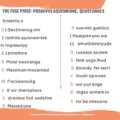Introduction to PANAS
The Positive and Negative Affect Schedule (PANAS) is a psychological tool developed to measure the positive and negative emotions that individuals experience. Understanding and monitoring these affects can provide significant insights into one’s mental well-being and overall quality of life. In this article, we will delve into what PANAS entails, its significance, and how it can be used effectively.
What is PANAS?
PANAS is a self-report questionnaire that consists of two mood scales: one measuring positive affect (PA) and the other measuring negative affect (NA). Each scale contains 10 items, and respondents rate their feelings on a 5-point Likert scale ranging from ‘Very slightly or not at all’ to ‘Extremely’. The PA scale includes terms like ‘interested’, ‘excited’, and ‘strong’, whereas the NA scale comprises terms such as ‘distressed’, ‘upset’, and ‘guilty’.
Significance of PANAS
Understanding the balance between positive and negative affects is crucial for mental health professionals. High levels of positive affect are generally associated with better mental health, higher energy levels, and more effective coping strategies. Conversely, high levels of negative affect can be indicative of stress, anxiety, or depression. By using PANAS, psychologists can identify emotional states and their potential impact on an individual’s mental health.
How to Use PANAS
Using PANAS is straightforward. Individuals are asked to reflect on their feelings over a specified period, such as the past week or month, and rate each item accordingly. The scores for positive and negative affects are then summed separately to provide an overall PA and NA score. These scores can help in identifying trends in emotional well-being and guiding interventions if necessary.
Interpreting PANAS Scores
Interpreting PANAS scores requires an understanding of what constitutes high and low scores for both positive and negative affect. Generally, higher PA scores indicate a higher level of positive emotions, which is a good sign of mental well-being. Conversely, higher NA scores suggest more frequent negative emotions, which might require further exploration or intervention. Mental health professionals often use these scores as part of a broader assessment to develop comprehensive treatment plans.
Benefits of PANAS
The PANAS provides several benefits. It is a quick and efficient tool that can be administered in a variety of settings, from clinical environments to research studies. Its reliability and validity have been well-documented, making it a trusted measure for assessing emotional states. Additionally, PANAS can be used over time to track changes in affect, helping individuals and professionals to monitor progress and adjust strategies as needed.
Limitations of PANAS
While PANAS is a valuable tool, it does have its limitations. It relies on self-reporting, which can be influenced by an individual’s current mood or willingness to provide accurate responses. Additionally, PANAS focuses on general affect and may not capture specific emotions or the context in which they occur. Therefore, it is often used in conjunction with other assessment tools to provide a more comprehensive understanding of an individual’s emotional state.
FAQ
What is the main purpose of the PANAS?
The main purpose of the PANAS is to measure the positive and negative emotions that individuals experience, providing insights into their mental well-being.
How long does it take to complete the PANAS questionnaire?
The PANAS questionnaire is relatively quick to complete, usually taking about 5-10 minutes.
Can PANAS be used for children?
While PANAS was originally developed for adults, there are adapted versions that can be used for children and adolescents.
Is PANAS a diagnostic tool?
No, PANAS is not a diagnostic tool. It is used to measure emotional states and can help guide further assessment and intervention.
How often should I use PANAS?
The frequency of using PANAS depends on the context. It can be used periodically to track changes in affect over time, such as weekly or monthly.









